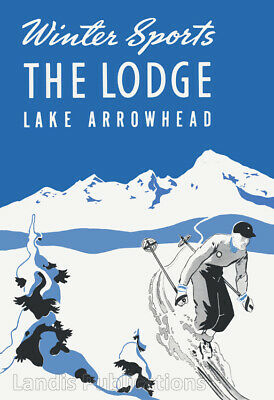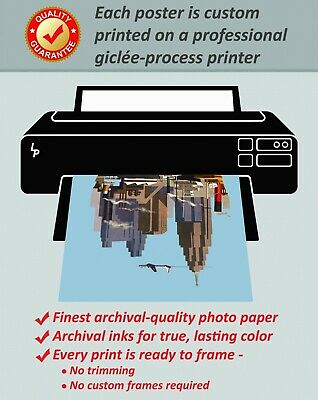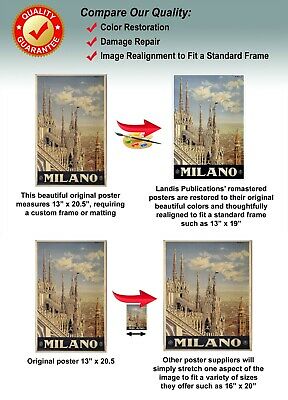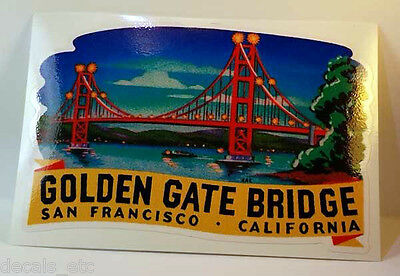-40%
The Lodge at Lake Arrowhead, Skiing & Winter Sports - 1940's Advertising Poster
$ 10.53
- Description
- Size Guide
Description
These are simply the best posters available! You will be thrilled with the image quality, vivid colors, fine paper, and unique subjects.This is an original vintage image that has been transformed into a beautiful poster - available exclusively from Landis Publications.
OUR POSTERS ARE SIZED FOR STANDARD OFF-THE-SHELF FRAMES, WITH NO CUSTOM FRAMING REQUIRED, PROVIDING HUGE COST SAVINGS!
This beautiful reproduction poster has been re-mastered from an original 1940’s advertising brochure for winter sports at the Lake Arrowhead Lodge, in the San Bernardino Mountains of Southern California. The vibrant colors and detail of this classic image have been painstakingly brought back to life to preserve a great piece of history.
The high-resolution image is printed on heavy archival photo paper, on a large-format, professional giclée process printer. The poster is shipped in a rigid cardboard tube, and is ready for framing.
The 13"x19" format is an excellent image size that looks great as a stand-alone piece of art, or as a grouped visual statement. These posters require
no cutting, trimming, or custom sizing
, and a wide variety of 13"x19" frames are readily available at your local craft or hobby retailer, and online.
A great vintage print for your home, shop, cabin, or business!
Lake Arrowhead History
Lake Arrowhead was originally conceived as part of a vast irrigation project to collect and deliver water to the parched communities and farmlands of the San Bernardino Valley.
In 1889, Adolph H. Koebig, San Bernardino city engineer, believed that water could be brought to the valley from the mountains to the north.
Koebig surveyed the mountains and found the area known as Little Bear Valley to be an excellent location for a reservoir and pipeline to San Bernardino. He also discovered that most of the major streams in the area flowed north, away from the San Bernardino Valley and into the Mojave River watershed.
The topography of the area complicated the development and the resulting water rights issues would eventually change the entire destiny of the project.
In 1890, Koebig successfully recruited an elite group of investors who put up ,000,000 to capitalize the new Arrowhead Reservoir Company. The project was named after the famous rock formation in the shape of a huge arrowhead on the face of the mountain at the foot of Waterman Canyon.
By 1894, construction on the intricate system of tunnels was well under way, but work on the project was more time consuming and costly than expected. Construction on the dam began in 1904 and was plagued by engineering problems from the start.
According to Tom Core, author and San Bernardino Mountain historian, “The Arrowhead dam is really a unique design, and it had a lot of problems. The weight of the earthen dam caused the concrete corewall to crack. With all the delays and repairs, the dam took almost 20 years to build.” The dam was raised to its final height of 185 feet in 1922 and a paved road across the top allowed driving access all around the lake.
From the beginning, litigation over water rights had troubled the project. Ranchers and farmers from Hesperia to Barstow were relentless in their efforts to prevent the Arrowhead interests from taking their precious Mojave River watershed.
The Arrowhead Reservoir and Power Company’s long legal battles over water rights finally came to a head in 1913. The Superior Court in San Bernardino sided with the desert water users and prevented the Arrowhead interests from diverting any water from the Mojave watershed. The decision put an abrupt end to the company’s 22-year vision of selling irrigation water to the San Bernardino Valley, and forced a complete change in plans.
With their irrigation plans in ruin, the company redirected the project and decided to capitalize on the recreational possibilities of the lake and surrounding properties. During construction of the sparkling new lake, property values in the area had increased some 4,000 percent and the company began developing and selling valuable parcels.
In 1921, a well-financed Los Angeles syndicate purchased the properties and changed the name of the lake to Lake Arrowhead.
The new owners launched a major advertising campaign and in 1922, the original Lake Arrowhead Village was opened in a gala celebration. Ads in California’s magazines and newspapers touted the area as “California’s Finest Playground.” Development flourished in the 20’s and the company promoted nightly dances and competitions including sailing regattas, swimming events, and beauty contests.
The lush Alpine look of the area and the proximity to Los Angeles made Lake Arrowhead a favorite movie location and also attracted many of Hollywood’s elite.
Southern Californians found the lake to be an ideal recreation destination and resorts and vacation homes sprouted up all across the mountain. In 1975, the property owners in Arrowhead Woods collaborated and purchased the lake and beaches and formed the Lake Arrowhead Association.
In 1977, the owners of the village and lodge properties unveiled a plan to build a totally new commercial village. As part of a training exercise, the local fire departments were allowed to burn the old village to the ground in a demolition project known as “The Big Blaze of 1979.”
The original purpose and use of Lake Arrowhead has changed course dramatically over the years.
According to Bob Bernier, Lake Arrowhead’s Water Operations Supervisor, “The lake is now used for recreation and to supply upwards of 7,000 residential and commercial water customers. We’re making a major proactive effort to conserve water to maintain the lake level and provide water service to our customers.”
Today, the waters of Lake Arrowhead provide an aesthetic and economic centerpiece for the surrounding community and supply vital water services to residents and businesses.













